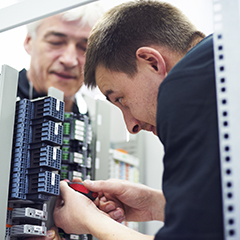Battery cell control system extends lifespan of storage devices and reduces costs
Munich, Germany, 11th June 2015 – At the Intersolar Europe exhibition in Munich, storage systems manufacturer ASD Automatic Storage Device has unveiled the first energy storage solution that connects battery cells in parallel as opposed to in a series. Electronic cell management significantly increases the performance and lifespan of the storage device and enables battery cells and storage systems to be manufactured at a considerably lower cost around the world.
For press photos and a video, please visit:
http://www.asd-sunstorage.com/pacadu-technology/
“Until now, the industry has been unable to produce electricity storage systems capable of working reliably at a high capacity and with low maintenance costs for very long periods of time. Our battery cell control system now enables storage devices that have greater durability to be produced much more simply and economically than before. This will give an unexpected boost to the entire industry and the e-mobility market,” reports Wolfram Walter, Managing Director of ASD and inventor of the ASD solar storage device and the battery cell control system Pacadu. “We have discussed and developed the cell management solution with researchers from around the world and have now integrated it into our own large-scale storage device for the first time. In principle, the control unit is the ABS of energy storage. With it, cell quality is no longer an important factor.”
ASD spent around a year successfully testing several prototypes of its new lithium-iron-phosphate storage system with “Pacadu inside” and is now preparing to launch the product on the market. The Freiburg-based company has filed 14 patents for the technology. Each cell in the new large-scale storage device is fitted with the intelligent Pacadu storage system, enabling all cells to be connected in parallel.
Previously, the battery cells used for energy storage worldwide have always been connected in series. Since the individual cells in a storage system age at different rates, the weakest cell determines the performance of the entire series. Furthermore, a defective battery cell requires the entire battery to be replaced and the properties of the cells that are connected in series must be the same or as similar as possible.
The industry and research institutes have invested billions into developing cells that maintain the same condition throughout their lifespan. Before configuring a storage system and connecting the cells in series, manufacturers must check whether the cells have the same internal resistance, charge status and health. In order for the storage system to function, the cells in the series must even come from the same production batch wherever possible.
“A storage device with cells connected in series works well at first. However, when the performance of the entire system is hampered by one cell after around three to five years, this faulty cell cannot be changed for a new one because the capacity, internal resistance and health of the new cell would not match that of the existing cells that have already aged,” explains Walter. “This ultimately means that anyone investing in an energy storage system is taking on a significant risk. To compound matters, the larger the storage device, the greater the risk for the investor.”
In contrast, ASD’s Pacadu storage system allows for defective cells to be exchanged. What’s more, if cells featuring the latest technology are used as replacements, the storage system is constantly modernised throughout its lifespan. This is because the Pacadu control system enables any number of cells to be combined regardless of their performance, manufacturer and even the cell technology at play.
Storage systems based on this innovation have an efficiency rating of 93%. The solution is currently in the certification process and is expected to be available this autumn as a modular, scalable system with individual module sizes of up to 3.2 kWh and a performance of 1 kW. ASD not only uses the smart cell control system in its own large-scale storage devices, but also sells the electronic system separately.
About ASD
ASD Automatic Storage Device GmbH is headquartered in Umkirch, near the German city of Freiburg. The company was founded in May 2013 by engineers Wolfram Walter and Gerd Knoll. It produces intelligent solar energy storage systems that use lithium-iron-phosphate battery technology and are manufactured in Germany. ASD received the German Renewables Award in autumn 2013 for its innovative storage technology.


























